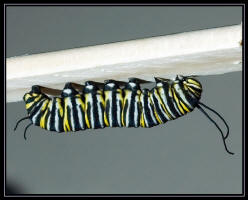 The caterpillar locates a site to pupate and a gland in its lower mandible produces a tiny silk pad in which to secure itself. |
|
Monarch Life Cycle Unless otherwise noted, all images on
this site are the property of Shawn Ashbaugh. Contact info: sashbaugh@austin.rr.com |
|---|
 The caterpillar locates a site to pupate and a gland in its lower mandible produces a tiny silk pad in which to secure itself. |